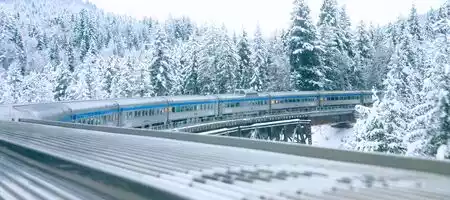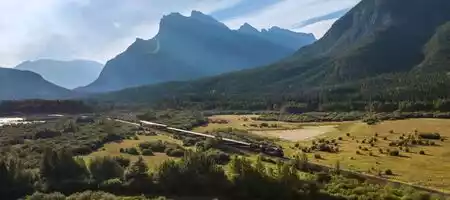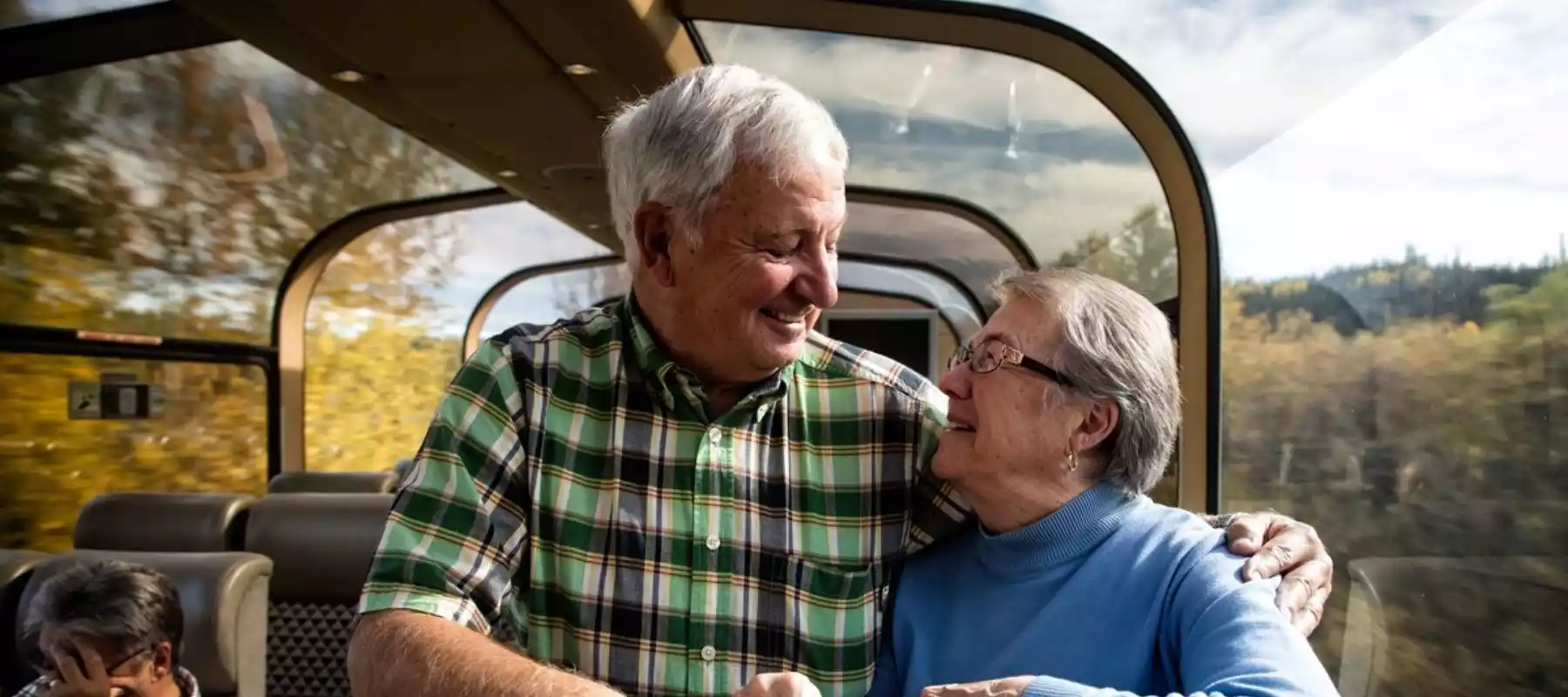
Last updated: May 28, 2025
Quietly, in the middle of a golden prairie field, a train carries on across Canada. It’s not fast, but, then, that’s what draws its riders in. It passes by towering peaks by day and, once you have been rocked and lulled to sleep, the world continues to rush under the expansive starry night sky. And, as dawn peaks over the horizon of the mountains, the plains, the ocean, the train journeys on ever still. A lucky few (those who have chosen the slow route) watch through eager eyes and domed glass skies as the wild landscapes wake again. Because, on a train across Canada, it really is about the journey.
A train across Canada is a bucket list trip that undoubtedly requires lots of planning. You are, after all, covering a lot of ground. To get you started, we will cover the basics here:
- History of the train across Canada
- Major train routes in Canada
- How to take a train across Canada
- Life on the trans-Canada train
- Where to stop on the trans-Canada train
- Popular train trips across Canada
- A Q&A with an expert
But if that’s not enough, reach out to one of our Travel Designers. As experts in traveling Canada by train (and having done it themselves many times), they’ll be able to answer any questions you have and put together your dream Canadian train adventure.
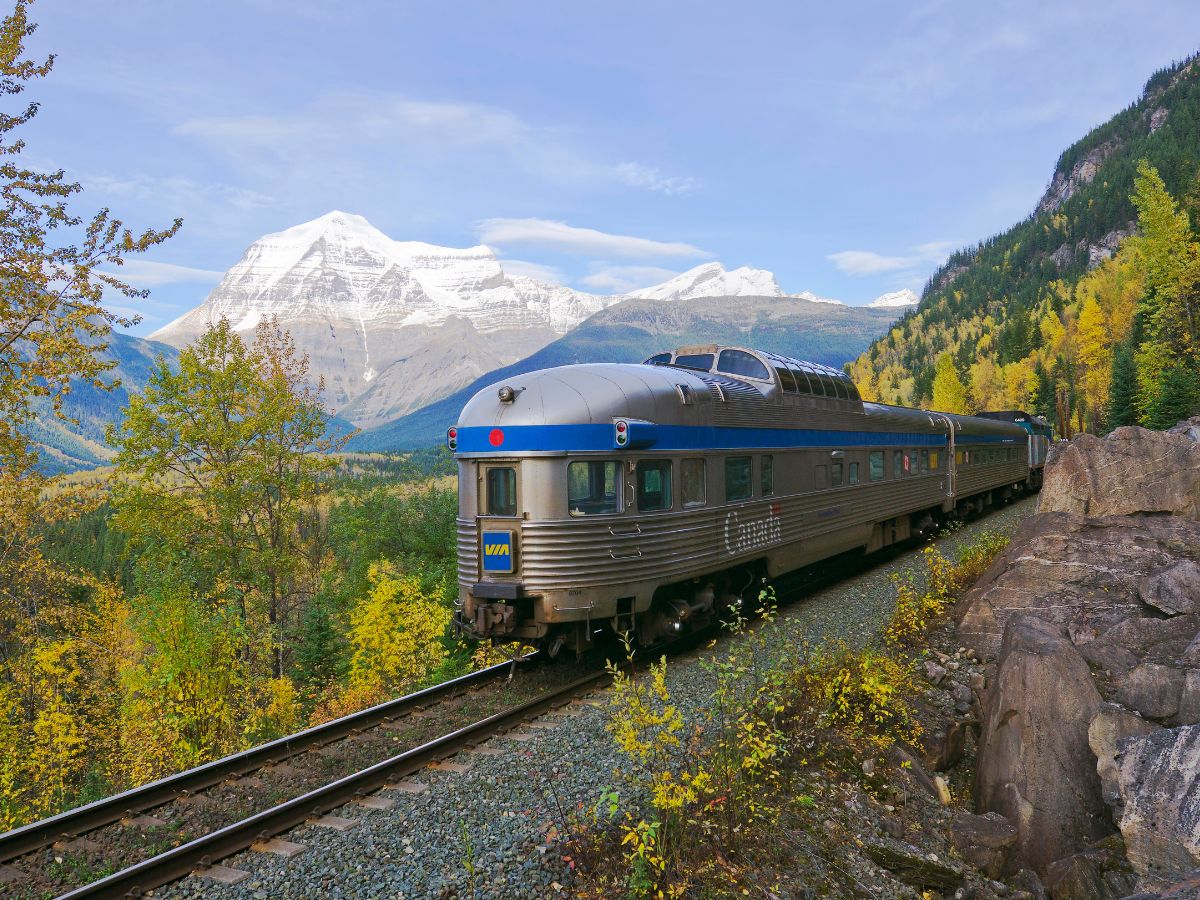 The Canadian traveling through the Rockies
The Canadian traveling through the Rockies
History of the Train Across Canada
Canada wouldn’t exist as it does today without the rail.
Rail travel in Canada started small — the first line between La Prairie on the St Lawrence River and St John’s (not to be confused with the current St John’s, Newfoundland — now Saint-Jean-sur-Richelieu) in Québec. Following the Canadian Confederation in 1867, a transcontinental railway was put into works by the Canadian Pacific Railway to connect the prairies and British Columbia with the rest of the newly established Canada.
At that time, the Canadian railroad was necessary for incorporating the far-flung regions into the Canadian Confederation, providing the promise of trade and migration routes. And the following railway boom saw many train operators open up new routes across the country.
But it didn’t last long. Following the financial stress of two world wars and the introduction of widespread automobile and air travel, the use of the railways slowed. And, in the years to come, both declining ridership and government budget cuts saw the discontinuation of once-popular trains.
Now, the trans-Canada train functions a little differently.
While many Canadians still use the trains in Canada as a practical mode of transport, (especially in the eastern provinces where stops are located relatively closer together than, say, the prairies where everything is decidedly not close together) the trans-Canada train doesn’t often see this same use. Instead, it exists to showcase the stunning views across the country for travelers with a little more time on their hands.
 Map showing the lines and stops on VIA Rail - courtesy of VIA Rail
Map showing the lines and stops on VIA Rail - courtesy of VIA Rail
Major Train Routes in Canada
Despite declining ridership, many short and long train lines still connect cities across Canada. The dominant rail provider is VIA Rail, offering the most expensive routes across the country. But they are not the only option.
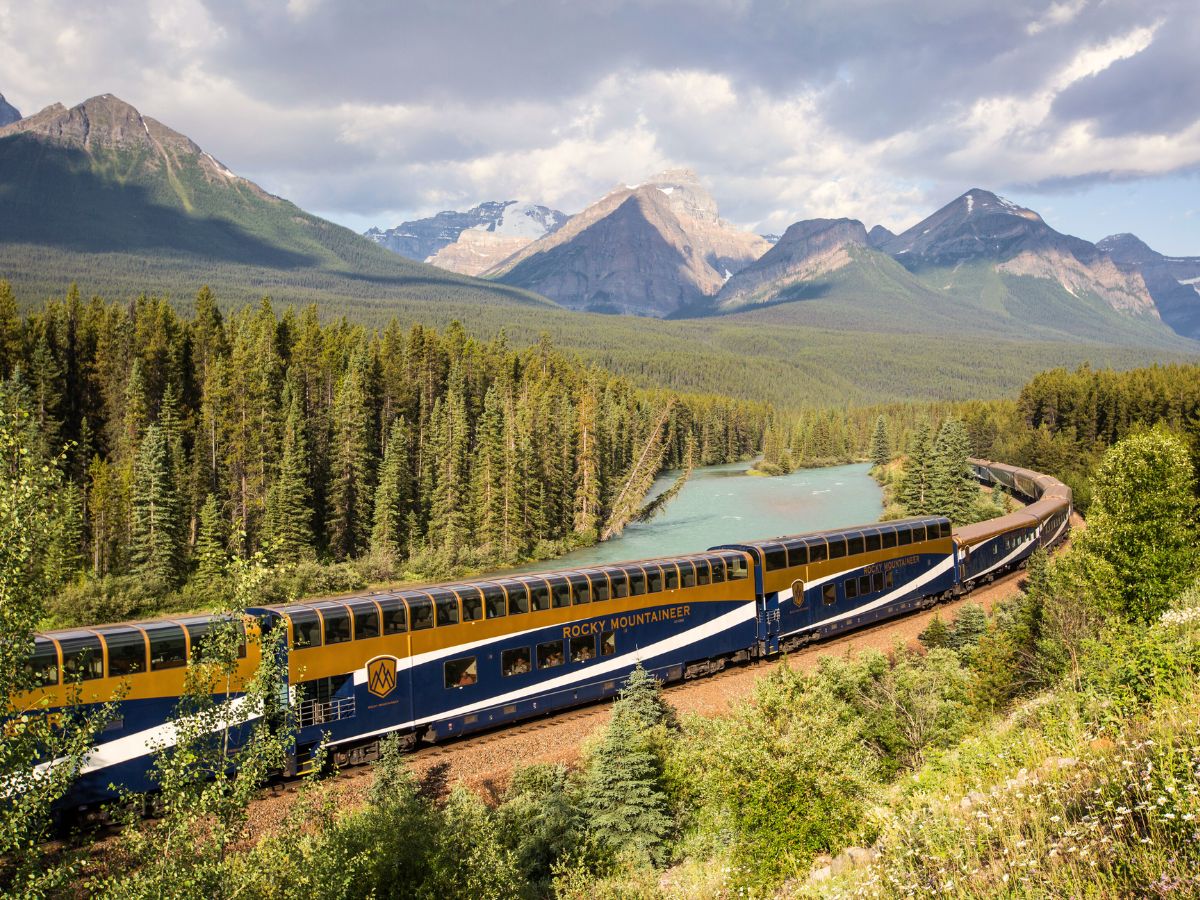 The Rocky Mountaineer snaking through the mountains
The Rocky Mountaineer snaking through the mountains
Rocky Mountaineer
Of all the trains in Canada, the most famous is arguably the Rocky Mountaineer, providing a luxury train trip through the Rocky Mountains from April to September.
As the Rocky Mountaineer is a sightseeing trip first and foremost, the train will slow at key points of interest, giving time for the onboard hosts to tell you all about the cragged peaks and plunging valleys in front of you. And, so that you don’t miss anything, each night travelers get put up in a hotel along the route, saving the railway views for sunlight hours.
The Rocky Mountaineer operates 3 routes through the Canadian Rockies: between Vancouver and either Banff or Jasper. And what is it like on board? Well, it’s pure luxury. But more on that to come.
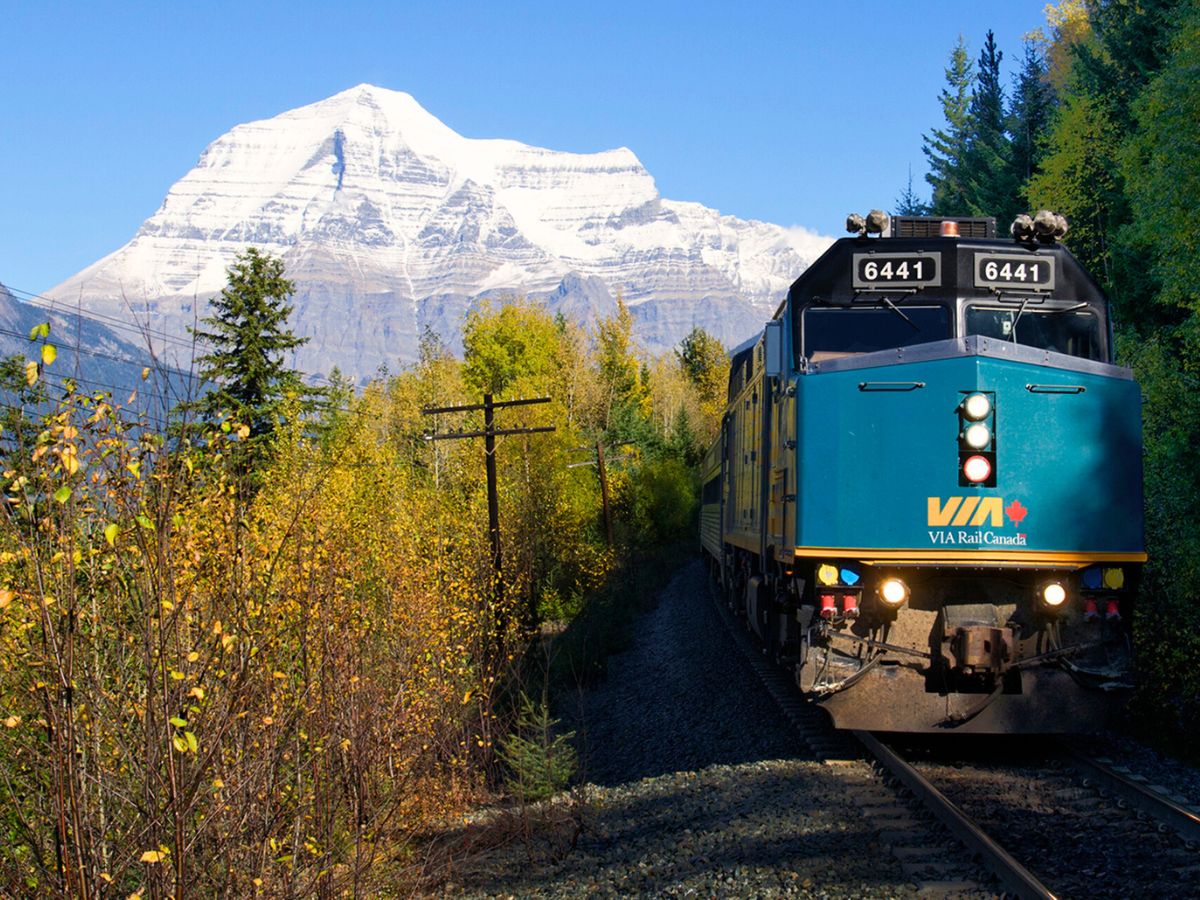 The Canadian traveling by Mount Robson
The Canadian traveling by Mount Robson
The Canadian
The Canadian is the train most frequently associated with a ‘train trip across Canada.’ Running between Toronto and Vancouver in either direction, this is Canada’s trans-continental line run by VIA Rail. From The Canadian, travelers see everything from towering rocky mountains to vast, seemingly endless plains to lush, lake-studded woodland.
The route takes 4 nights from the outset to its terminus station, and in that time travelers stay on board in either seat, semi-private berth, or private cabin (but more on service levels later).
Route highlights include Vancouver, either the departure or terminus station, the mountain town of Jasper, and Toronto, at the opposite end of the line (and, of course, all the stunning scenery along the way).
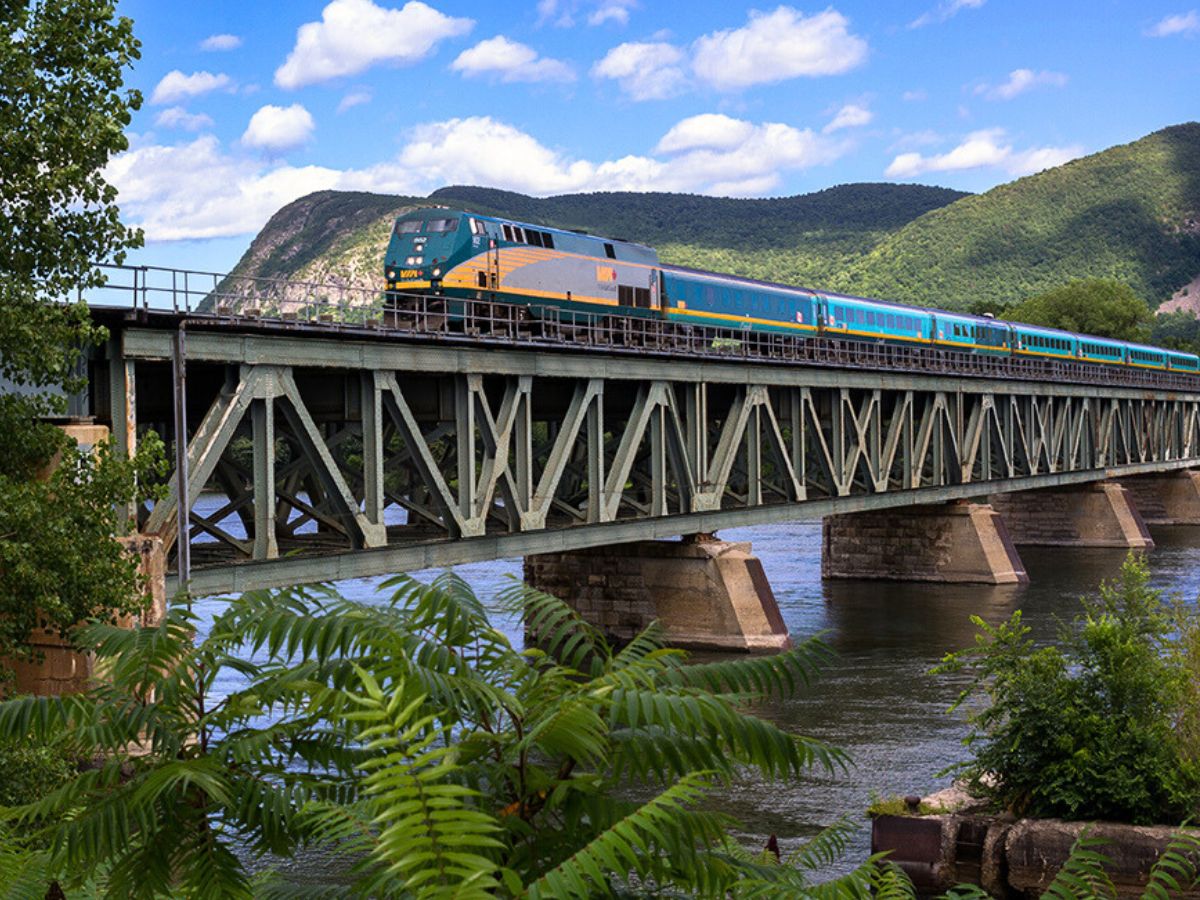 The Corridor train passing through Québec
The Corridor train passing through Québec
The Corridor
Also operated by VIA Rail, The Québec City–Windsor Corridor (usually just called The Corridor) runs through Ontario and Québec. The route begins in Windsor, in the south of Ontario, and ends in Québec City, in Québec (the province).
If you were to take the route in its entirety, it would take between 16 and 22 hours (depending on the departure time) and include 2 train changes.
This route stops in many iconic cities, including Ottawa, Niagara Falls, Toronto, Montréal, and the aforementioned Québec City.
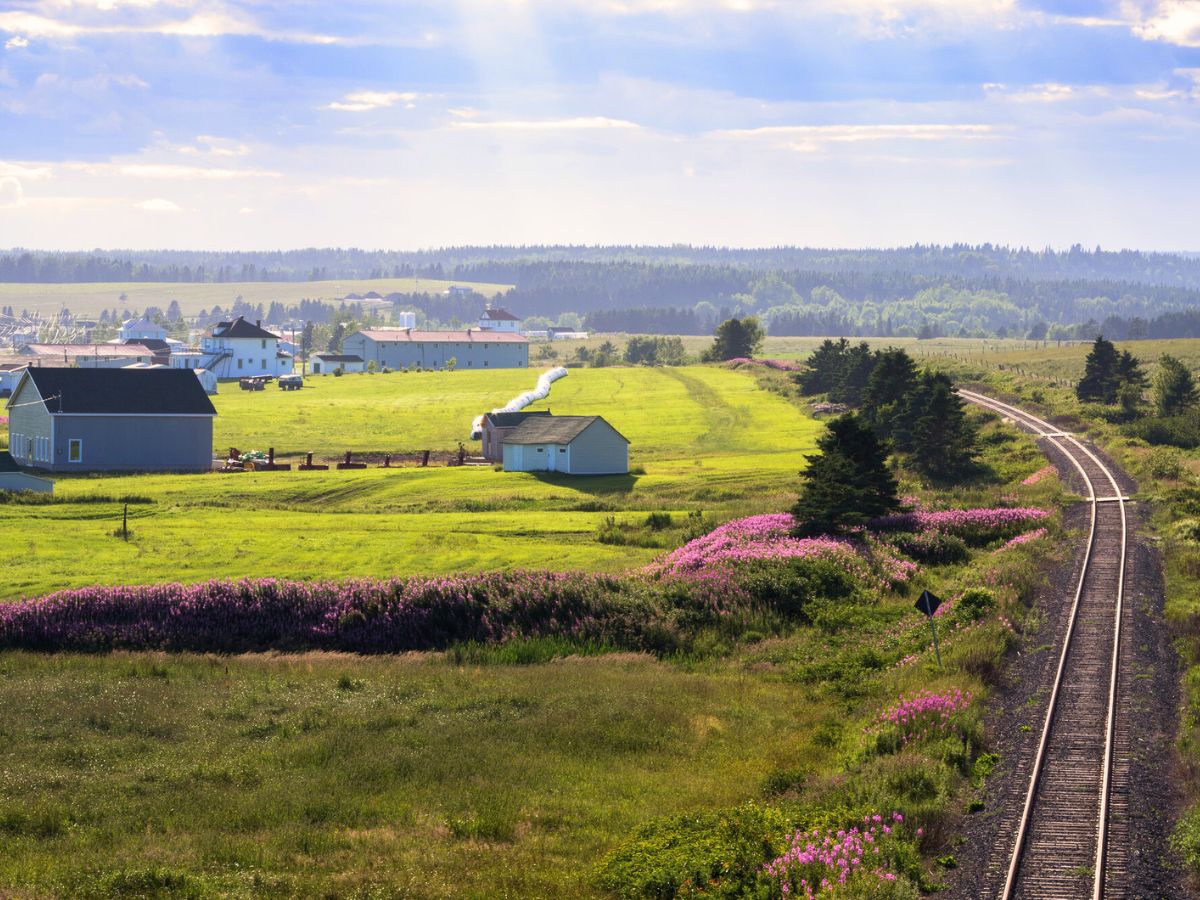 The Ocean train’s route through maritime towns and villages
The Ocean train’s route through maritime towns and villages
The Ocean
The Ocean is the oldest continually operating railway line in Canada, running between Montréal in Québec and Halifax in Nova Scotia. Originally run by the Intercolonial Railway of Canada, it is now also owned by VIA. On its way, the train passes through Québec to New Brunswick and Nova Scotia, connecting Atlantic Canada with the rest of the country.
From end to end, a journey on The Ocean would take a few minutes shy of 23 hours. Highlights include views of charming, maritime towns and the lush landscape of Canada’s East Coast.
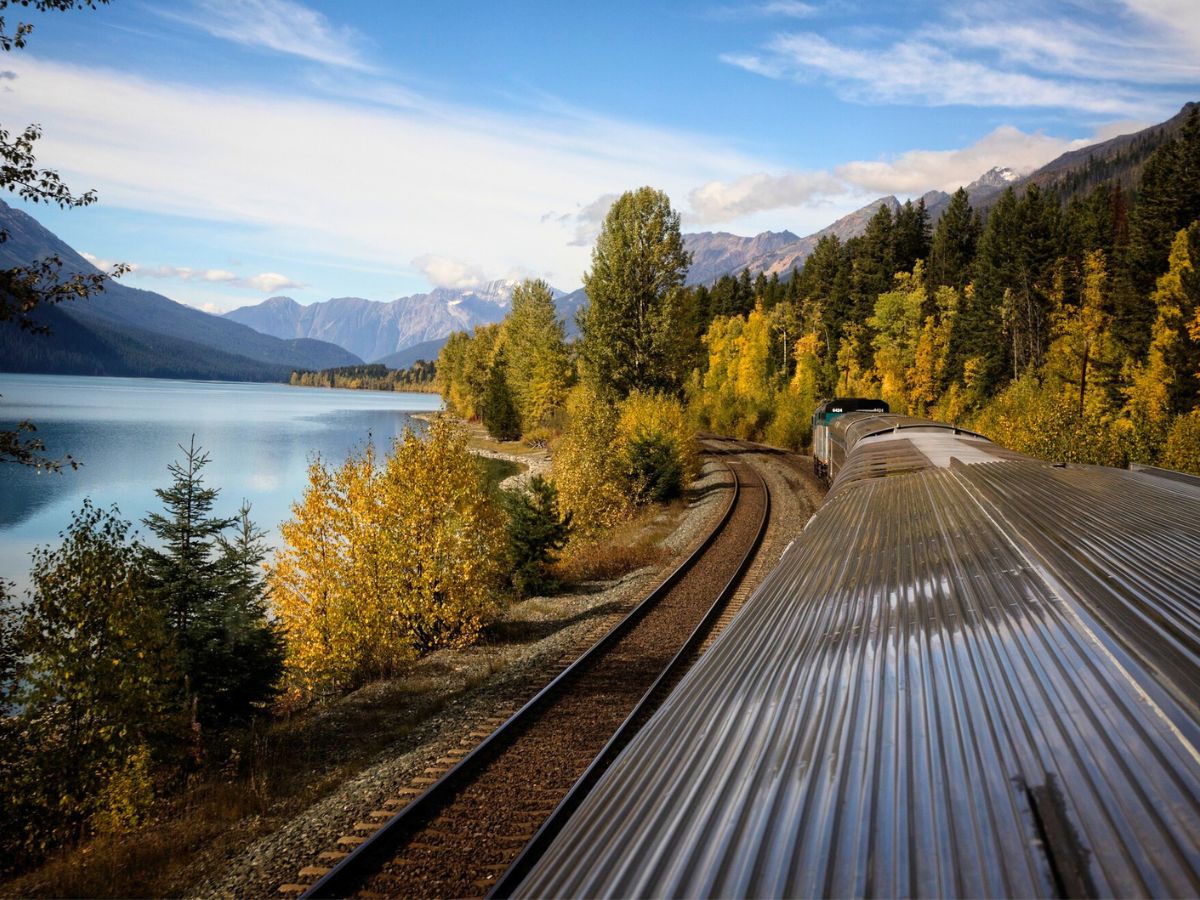 The Skeena scenic adventure route, from Jasper to Prince Rupert
The Skeena scenic adventure route, from Jasper to Prince Rupert
Scenic Adventure Routes
Across Canada, four lines make up VIA Rail’s Scenic Adventure Routes and connect remote areas of the country. While a key method of transport for many communities without road access, these trains also provide a great opportunity for travelers to experience a Canada that most do not.
Each line offers different landscapes, from the rugged wild of the West to the rich and lush landscapes in the East and the endless open sky of the prairies. But our favorite connects to The Canadian in Winnipeg and runs as far North as you can go to Churchill.
Like much of Canada’s far North, Churchill has no road access. And, for visitors looking to explore the Polar Bear Capital of the World, it offers an alluring alternative to air travel. Our Travel Designers love helping you design custom experiences, just how you’d like them (with added advice from those in the know). So, if considering a Polar Bear package, also consider the views to and from the far North you could get from the train. And then ask about it — your Travel Designer would be thrilled you’ve found a hidden gem.
How to Take a Train Across Canada
Now let's say you want to see as much of Canada as you can, coast to coast. Here’s the route you want:
Start in Vancouver, and board The Canadian. You’ll be here a while (4 days), so we recommend booking a prestige-class ticket for the highest comfort and service during your stay (if you’re interested in this, jump down to the ‘Life on Board’ section). As this train ends in Toronto, spend a night here to ensure no delays make you miss your connection.
From Toronto, board The Corridor train, disembarking in Montréal (approximately 6 hours later). Again, spend a night here to ensure plenty of time for your connection.
Leaving the following evening, your last train is The Ocean, from Montréal to Halifax. This overnight train will be the end of your adventure.
So how long would this all take?
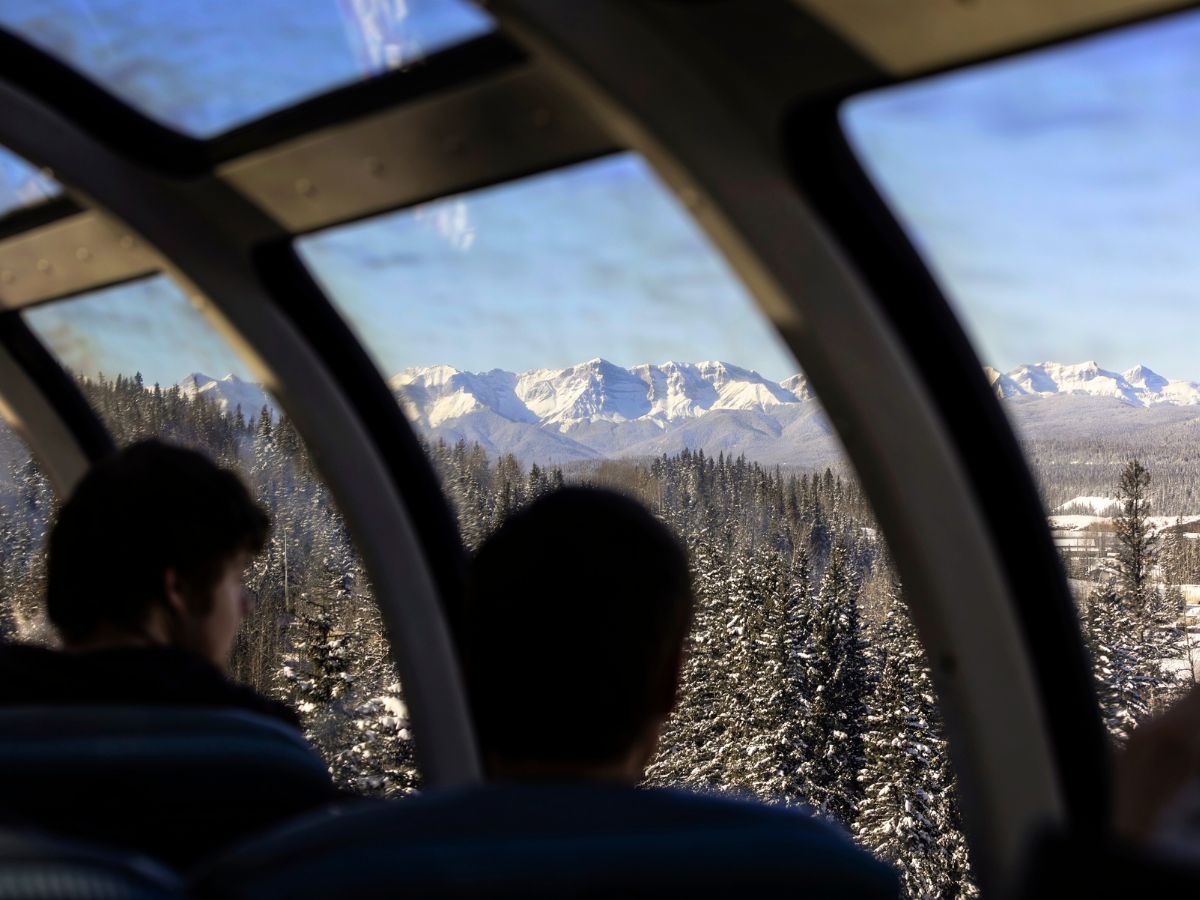 Winter view from The Canadian
Winter view from The Canadian
To complete a full trans-Canada train trip, stopping only at the (not required but strongly recommended) connection cities would take 7 days, with about 126 hours of on-board train time. The route can also be done in reverse — from Halifax to Vancouver, but it is worth noting prices are typically slightly higher when traveling East to West.
Of course, this is not the definitive way to see Canada by train. Most travelers like to stop along the way to spend more time in choice destinations (might we recommend Jasper to see the wealth of winter activities it offers?). In addition, taking the Scenic Adventure Routes connecting to The Canadian and The Corridor lets visitors see the real heart of the Canadian wilderness.
And if you want to go all out? Add a ferry to either end of your trip to see both Vancouver Island in the West and Newfoundland in the East. And, honestly, you can’t get more trans-Canada than that.
 Our Canada Rail Vacations team in the Bullet Lounge while touring The Canadian
Our Canada Rail Vacations team in the Bullet Lounge while touring The Canadian
Life on the Trans-Canada Train
Each train on the trans-Canada route has different offerings, service levels, food, and amenities.
The Canadian
Making up the bulk of the train trip across Canada, The Canadian also has the widest offerings of all the VIA Rail trains.
Some lucky members of the Canada Rail Vacations team recently had a private tour of The Canadian to learn all its secret ins and outs. We saw staff members preparing for their guests, bags placed in rooms, and canapes being plated ahead of boarding.
There are three levels of service: Economy, Sleeper Plus, and Prestige Class, as well as public lounge cars, and the famed Skyline car.
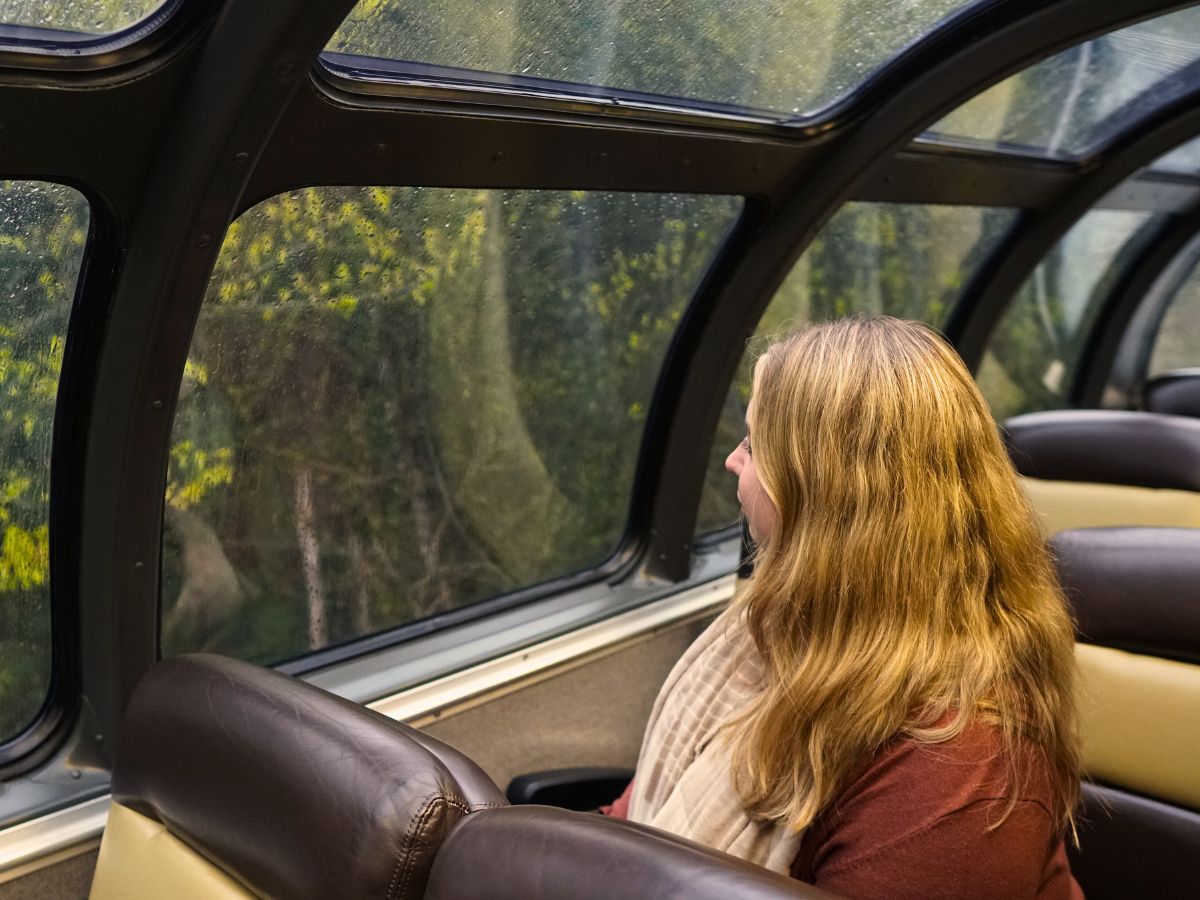 Senior Travel Designer Mandy enjoying the Skyline dome car on The Canadian
Senior Travel Designer Mandy enjoying the Skyline dome car on The Canadian
In Economy, passengers get a comfortable reclining seat, meals, and snacks for purchase, and access to both the lounge car and the skyline car. While Economy provides a more affordable way to experience a train trip across Canada, we only book Sleeper Plus and above to ensure our travelers travel in comfort. And, for four nights of train travel, we strongly recommend it.
Sleeper Plus comes with a few options for seats and rooms. Travelers can choose between semi-private cabins — bench-style seating by day and bunk bed-style berths covered by a heavy curtain by night — and private cabins for one to four guests, and share communal showers located in each car. For groups of three and four, two neighboring cabins can become one through a sliding partition wall, making Sleeper Plus perfect for family travel. This can be requested at no extra fee depending on availability when speaking with one of our Travel Designers.
In Sleeper Plus, you also gain access to the included meals in the dining car. Made to order by chefs on board, the meals become a real highlight on the train journey. And, what better way to spend your days than by taking in the views, and eating deliciously?
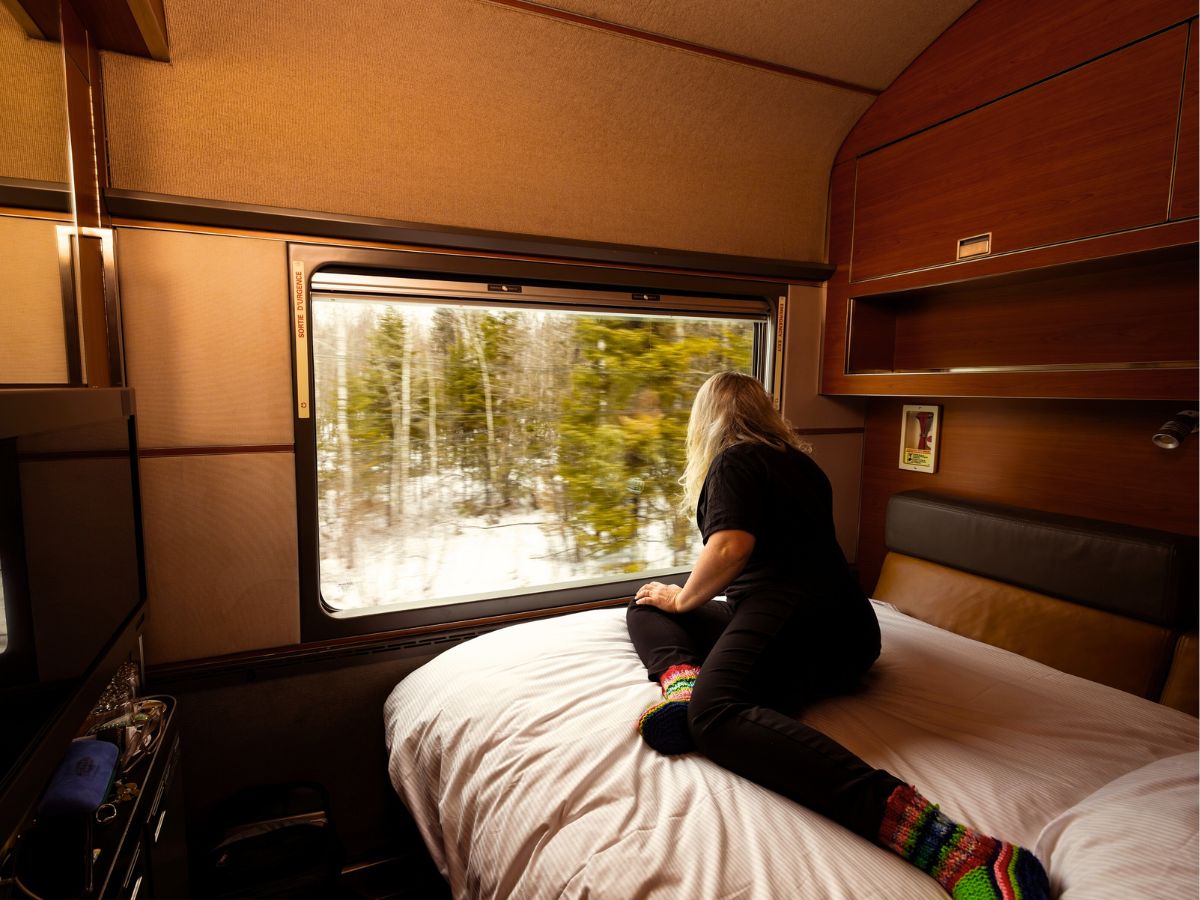 A bed with a view in Prestige Class
A bed with a view in Prestige Class
Prestige Class is that better way. Your private cabin comes with a large L-shaped leather couch that, when night rolls around, folds away in place of a comfortable bed for two, and a bathroom with a private shower. And, if that is not enough, Prestige Class travelers can look forward to priority access to the domed Skyline car, with the best seats in the car reserved just for you. When it’s time for dinner, you can enjoy priority reservations for your dinner slot and then retire to the Prestige-exclusive Park Car Bullet Lounge at the very rear of the train.
But what we learned on board The Canadian is that it really goes above and beyond in the community built on board.
Taking The Canadian is more than getting from A to B — it is about unwinding at a slower pace of travel. Internet access is severely limited on the train’s route, and that’s a good thing. From the social lounge cars to the communal dining (where groups get paired together to make up tables of four), the focus is on being present. And this was clear on board.
 The activity board, as seen on our private tour, is ready to be filled with community events for all passengers onboard
The activity board, as seen on our private tour, is ready to be filled with community events for all passengers onboard
Be it dedicated staff members arranging social activities (on the train we toured, the wonderful Lauren had everything from bingo to wine tasting to ‘yoga on the tracks’ planned for the journey) or chess boards painted on the lounge car tables, train travel in Canada is about taking the time to enjoy the journey.
To get the most out of this trip, Sleeper Plus is a must. Not only do you get more room, but you take advantage of the many amenities. So, regardless of what service level you book at, the number one recommendation is to get out and experience the unique atmosphere of the train.
After all, it’s what you’re there to do.
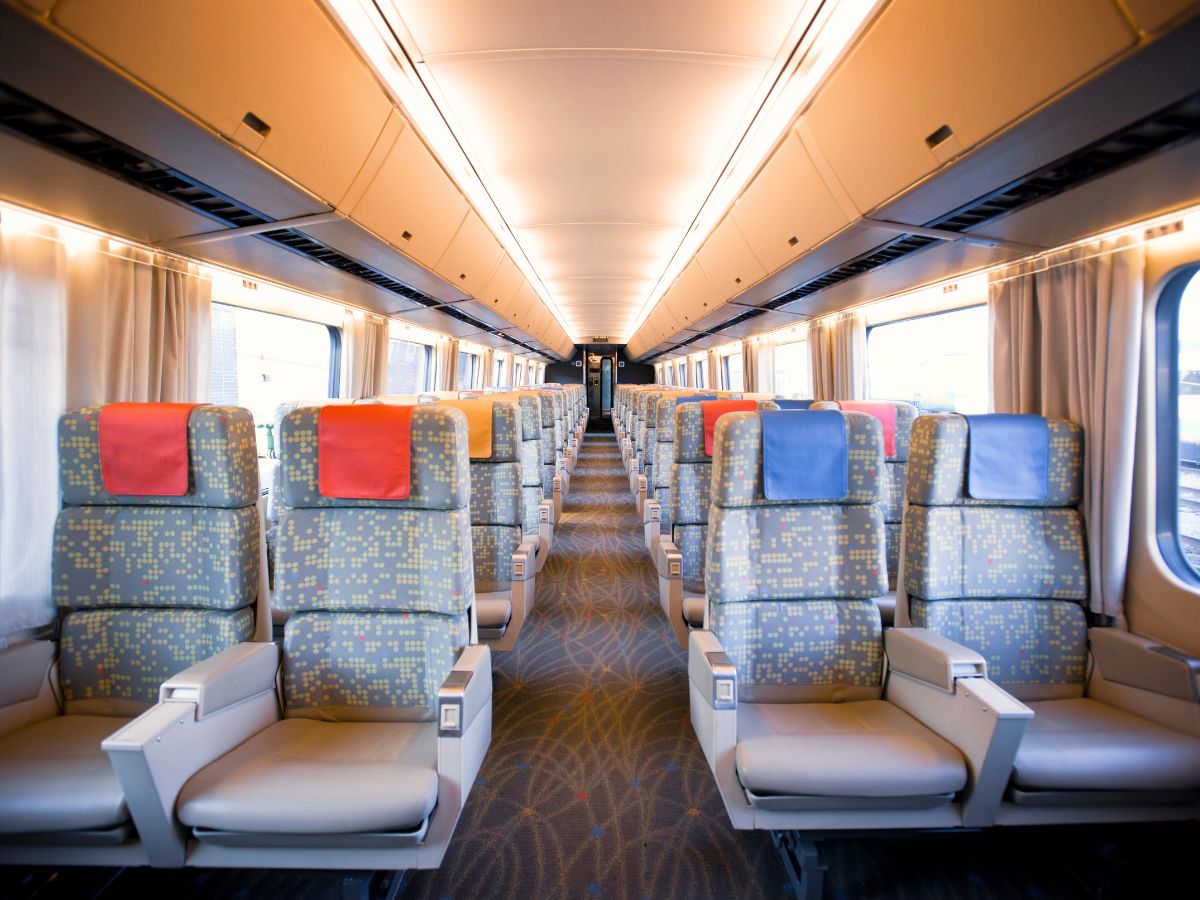 The Corridor’s interior
The Corridor’s interior
The Corridor
The Corridor train is frequented by inter-city commuters and functions more like a commuter train than one geared towards sightseeing. It therefore does not feature the Skyline ‘dome’ car. There are two service levels: Economy and Business.
In both Economy and Business, you get a spacious, reclining seat with power outlets and complimentary Wi-Fi. For business class, your seat is located in a business class-only coach, but the seat is the same.
The main difference between the service levels comes from the food. Economy travelers can purchase drinks, sandwiches, and lunchboxes on board. But, in Business class, catered-style meals are included in your trip.
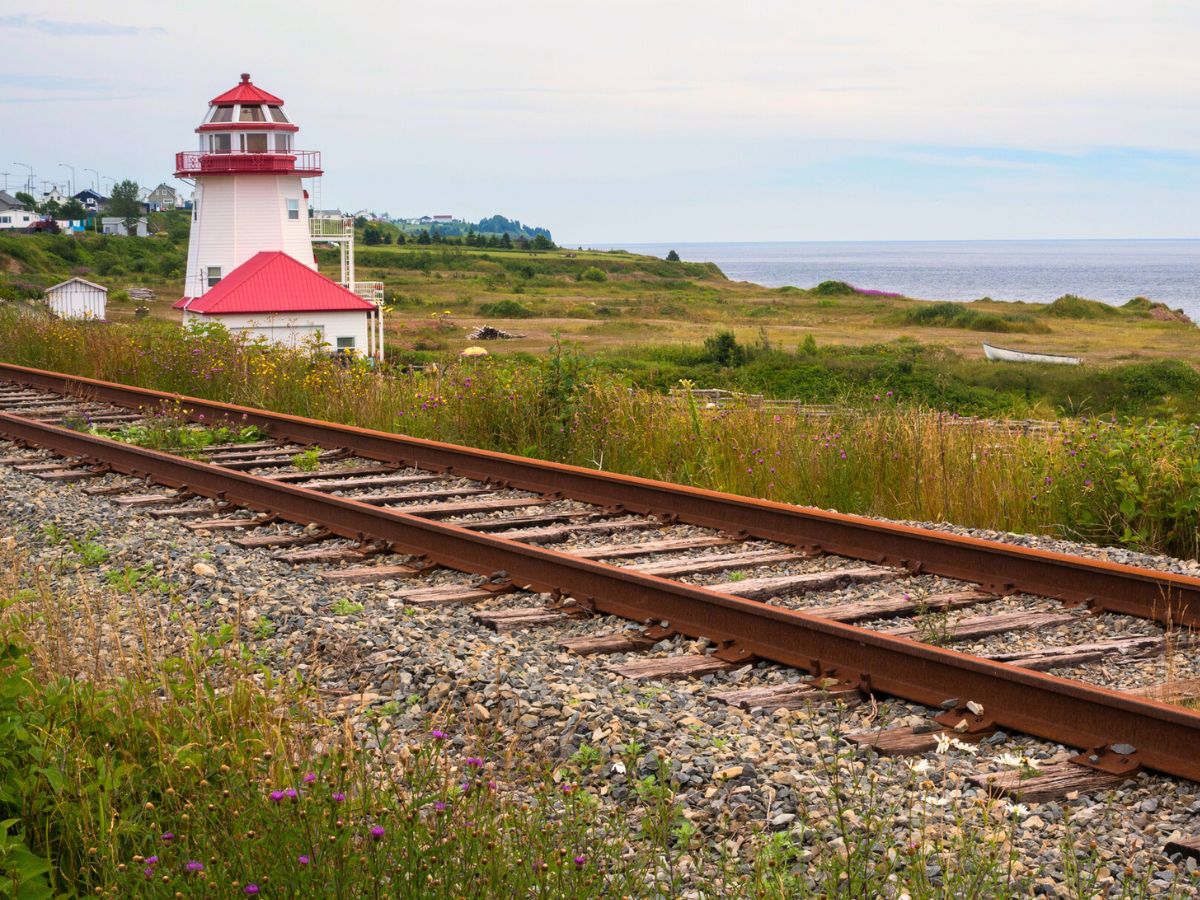 Views of the ocean from The Ocean train
Views of the ocean from The Ocean train
The Ocean
Another train servicing commuters more than tourists, The Ocean misses a few features that the Canadian has — the glass-dome viewing car being the most notable, and access to Prestige Class travel following hot on its heels. The Ocean has two service levels: Economy and Sleeper Plus.
In Economy, travelers have a wide and comfortable seat (that reclines, perfect for the nighttime hours), access to a lounge car, and food available for purchase.
In Sleeper Plus, you stay in a cabin for two. By day, the cabin is fitted with a comfortable bench-style seat (with plenty of room for one or two travelers). By night, the seat folds down into a bed. If a second bed is needed, it will appear — as if by magic — from the wall (please note: this is not magic. It, in fact, also folds out).
 Dining with a view in the Rocky Mountaineer’s GoldLeaf dining car
Dining with a view in the Rocky Mountaineer’s GoldLeaf dining car
The Rocky Mountaineer
The Rocky Mountaineer is the luxury option for seeing Canada’s West by train. There are three service levels: SilverLeaf, SilverLeaf Plus, and GoldLeaf
The SilverLeaf service gives guests a comfortable journey in custom-designed, single-layer cars with large, reclining seats and large windows with a domed top, to showcase the stunning mountain scenery. Gourmet meals are served to your seat at both breakfast and lunch (so your only worry is sitting comfortably and watching the world go by). In SilverLeaf Plus, you get all this and access to the lounge car, additional hosts, and premium cocktail and wine pairings at meals.
 The Rocky Mountaineer GoldLeaf dome car
The Rocky Mountaineer GoldLeaf dome car
The GoldLeaf service is the best of the best. Roll through the mountains and get a vantage point view in the top level of a custom-designed, bi-level coach. The glass-domed windows are bigger than SilverLeaf, meeting nearly seamlessly overhead, and offering full views of the mountains and sky above, and the reclining seats can be rotated to accommodate groups of four. When meals are served, GoldLeaf guests head to the lower level of their coach for a white-linin-tablecloth experience with gourmet meals — chef-prepared and made-to-order.
Secret Top Travel Tip
There is a hidden resource on board every single train that not nearly enough people know about — the staff! They make this trip several times a week and are a wealth of knowledge. Don’t be afraid to ask them any questions you might have about the train, the route, or any sights along the way.
Stops on the Trans-Canada Train
A trans-Canada train tour does not mean you are confined to your coach for a week straight. The train makes several stops along the route, ranging from minutes to hours, so passengers can jump out and stretch their legs. And, as same-day connections are not recommended due to potential delays in arrival time, overnight stops in connecting cities come by default.
But, that doesn’t mean you have to rush through the rest of the trip.
In addition to the strongly recommended layovers, many travelers choose to disembark along the way to explore their favorite regions. A trip across Canada is, after all, about seeing Canada. But choosing where to stay really depends on what you want to see.
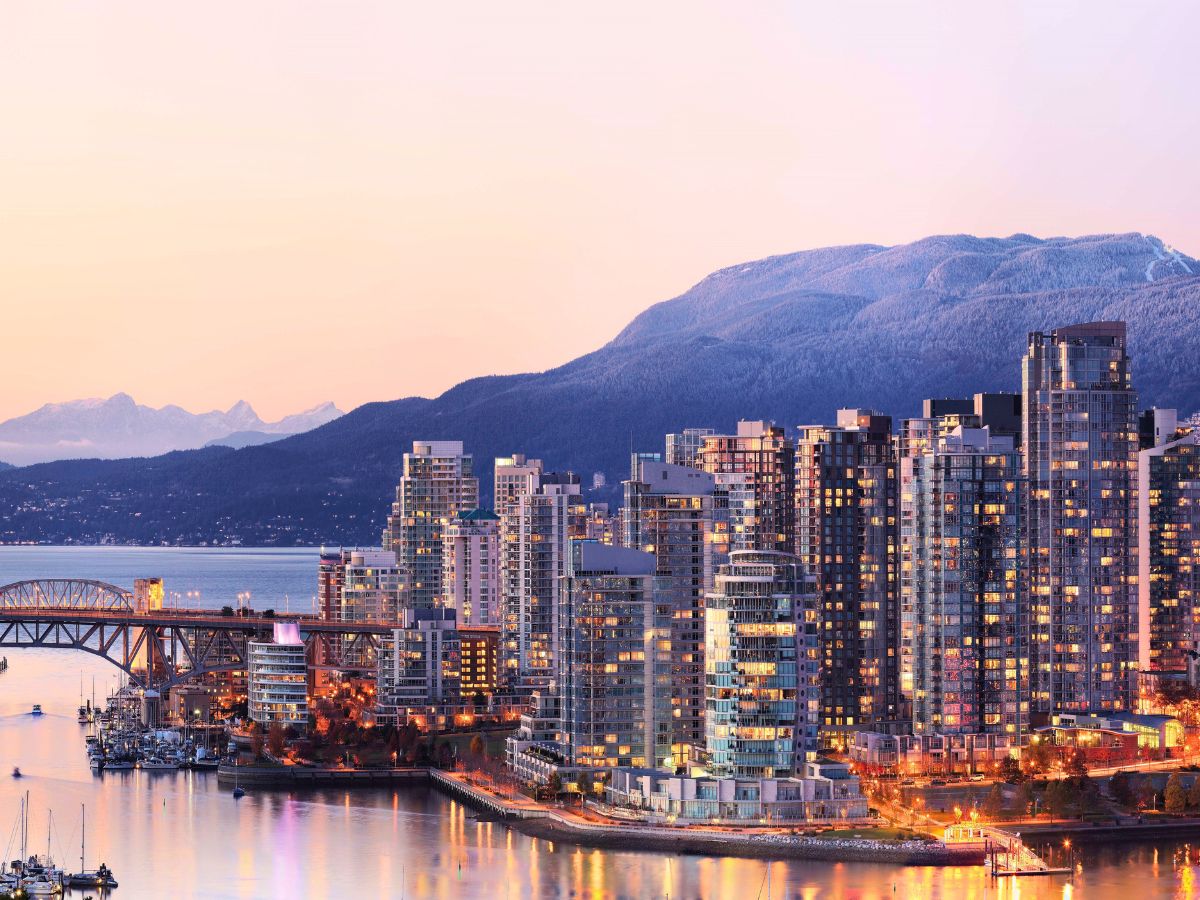 Vancouver, the start (or end) of your trans-Canada journey
Vancouver, the start (or end) of your trans-Canada journey
Vancouver
Vancouver is either the start or the end of most trans-Canada train tours. And, as a result, visitors will typically spend a night or two in the city before traveling onwards. It’s the city where the sea meets the mountains, and its love of all things ‘outdoorsy’ reflects this. From hiking to paddleboarding, Vancouverites take any excuse to get into nature (and recommend visitors do too). To best experience Vancouver’s nature, head to Capilano Suspension Bridge, which not only features the stunning suspension bridge but also a treetop adventure and cliff-side walk.
There is so much to do in Vancouver — adding a night to your trip to see more of the city and its surroundings would be a welcome opportunity. But, with just a day in the city, we would recommend biking the seawall, to see both the city and its beautiful shoreline, before diving into the city’s rich culinary culture.
With just one night, a stay in the Fairmont Hotel Vancouver is a must. It is, to put it frankly, stunning. Glamorous and luxurious from top to bottom, a stay here is everything you’d want from ‘the castle in the city.’ And, situated in the heart of downtown, it is ideally located for seeing the most of the city in the shortest time. Even with an extended visit, it makes for the perfect respite from the busy city.
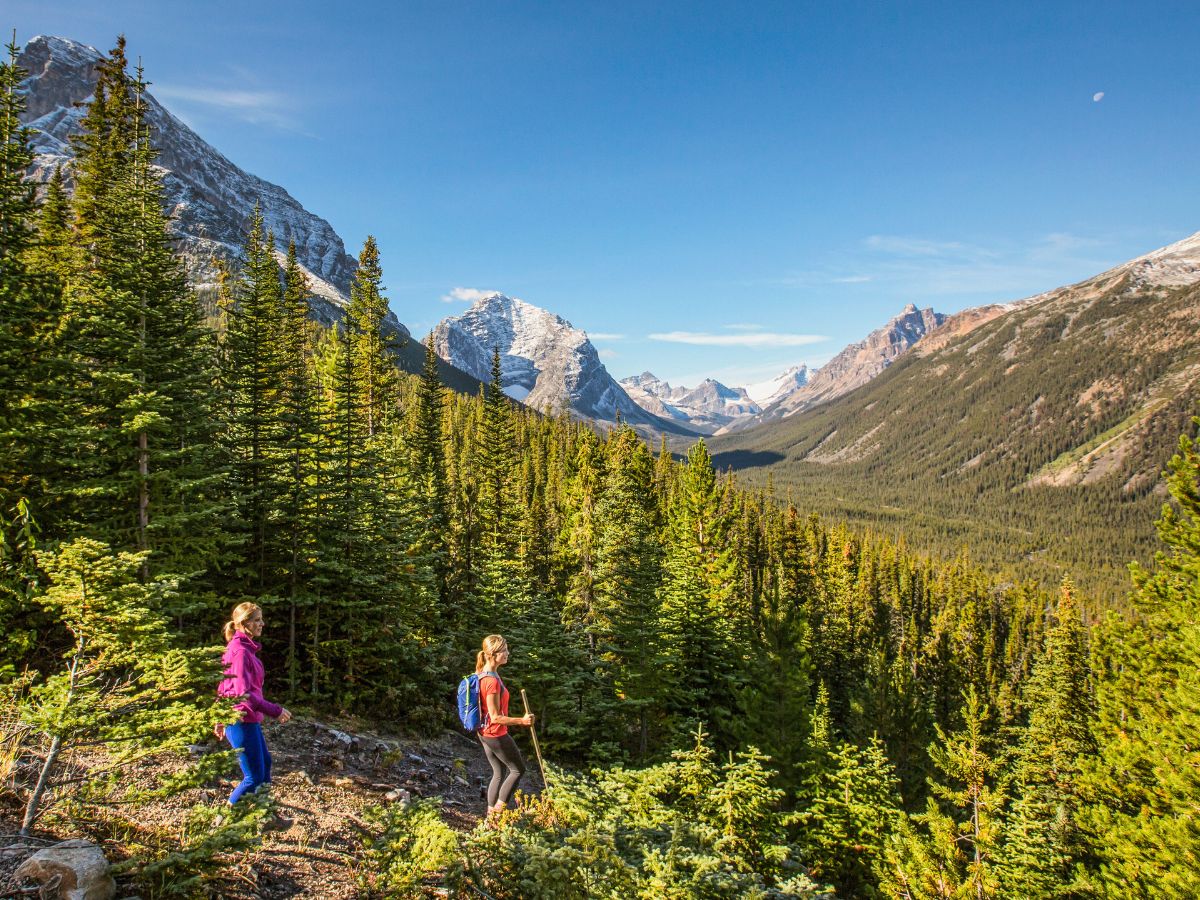 In Jasper, wilderness is king
In Jasper, wilderness is king
Jasper
When traveling through the Rocky Mountains by train, most visitors stop in Jasper, Alberta. This quaint mountain town is everything you would want from a town nestled in a forest between peaks. It is a must-stop if you want to fully experience the Rockies.
Depending on how you want to see the mountains, you can choose between The Canadian, traveling through the night and arriving in Jasper mid-morning, and the daytime-only Rocky Mountaineer. And, as a gateway to the rest of the Rockies, a longer stay in Jasper could be your jumping-off point to a Rocky Mountain adventure (before, of course, re-embarking on your journey).
A cabin in the woods is traditional in Jasper, but a night at Forest Park Hotel takes the concept and elevates it. Its newly opened Alpine Wing feels modern but retains rich pine finishes at every turn.
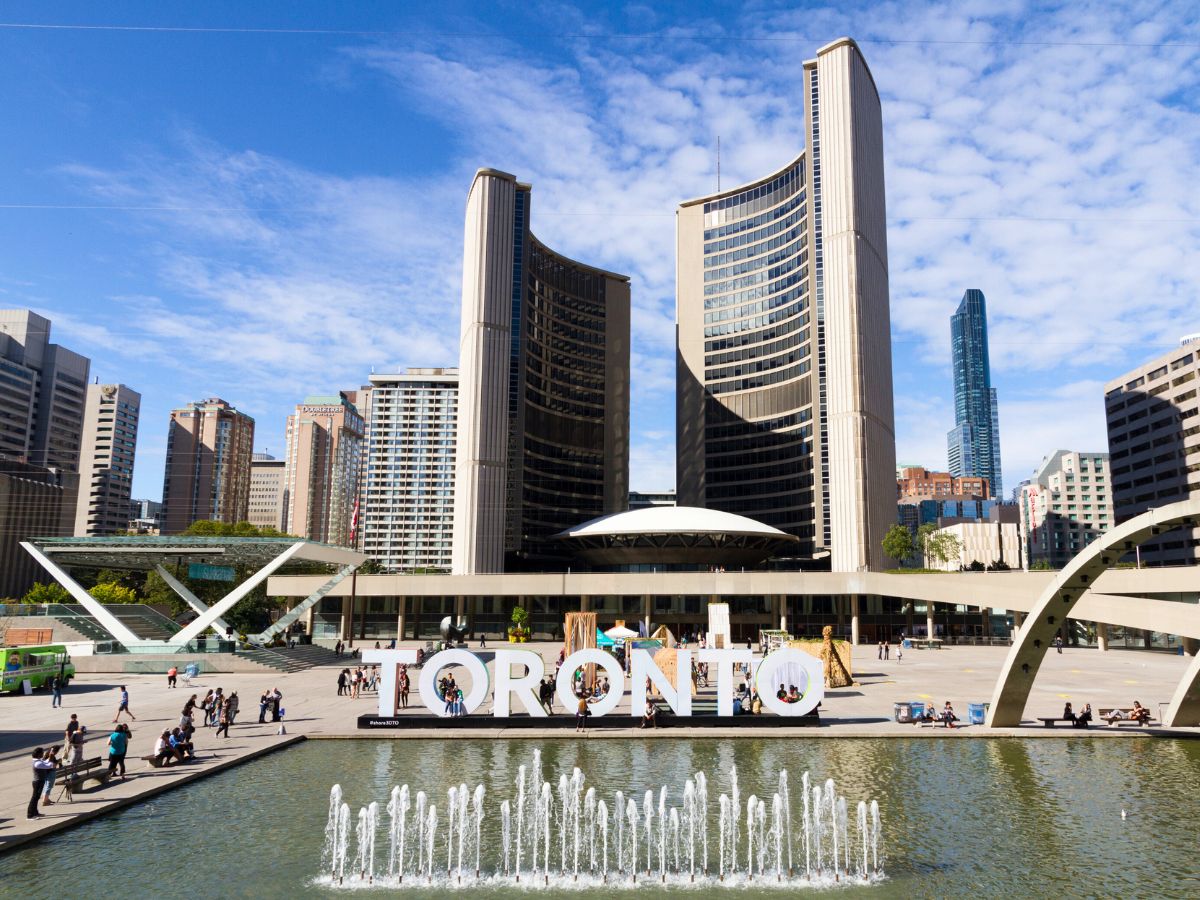 Toronto, Canada’s biggest city
Toronto, Canada’s biggest city
Toronto
As you swap from The Canadian to The Corridor, you will have a night’s layover in Toronto.
If you just have one day in the city, Toronto’s downtown core has lots to explore. Head up the iconic CN Tower, conveniently located close to the Union Station, for a view of the city. And, for train enthusiasts (we feel like there might be some on this trip), the Toronto Railway Museum is located practically next door. Heading slightly further afield, Kensington Market, still just a 30-minute walk from the tower, feels like an entirely different city. Boutiques and bakeries line its bohemian streets — a sharp contrast to the typical slick image people have of Toronto.
But, if you decide to stay a little longer, a day trip to Niagara Falls is easily accessible by public transit or private transfer.
 The beautiful streets of Old Montréal
The beautiful streets of Old Montréal
Montréal
Another transfer city, another day to explore.
Named a UNESCO City of Design, Montréal is Canada’s art and culture hub. And, if you consider food a core part of culture (and you should), you are in for a treat here. From the Québec-created, Canadian classic of poutine to a smoked meat sandwich to Montréal bagels — there’s a lot to try. And that is reason enough to spend an extra night here.
But the real draw of Montréal is its history.
Old Montréal is filled with small streets to explore and is best seen through a walking tour (so you don’t miss out on any historical tidbits that only a local would know). If you’re looking for a unique souvenir, tucked within the cobbled streets is the hidden gem Boutique Bonjour Montréal. They highlight the history and the culture of the city by highlighting local artists and artisans, offering a true slice of Québec to take as you journey onwards.
For your night in Montréal, stay at Hôtel Le Germain. Covered in a mesmerizing rainbow mural from head to toe, it wonderfully embodies the art and cultural hub of the city. Inside, guests are treated to rooms with modern decor and the city’s artful character embedded into every element.
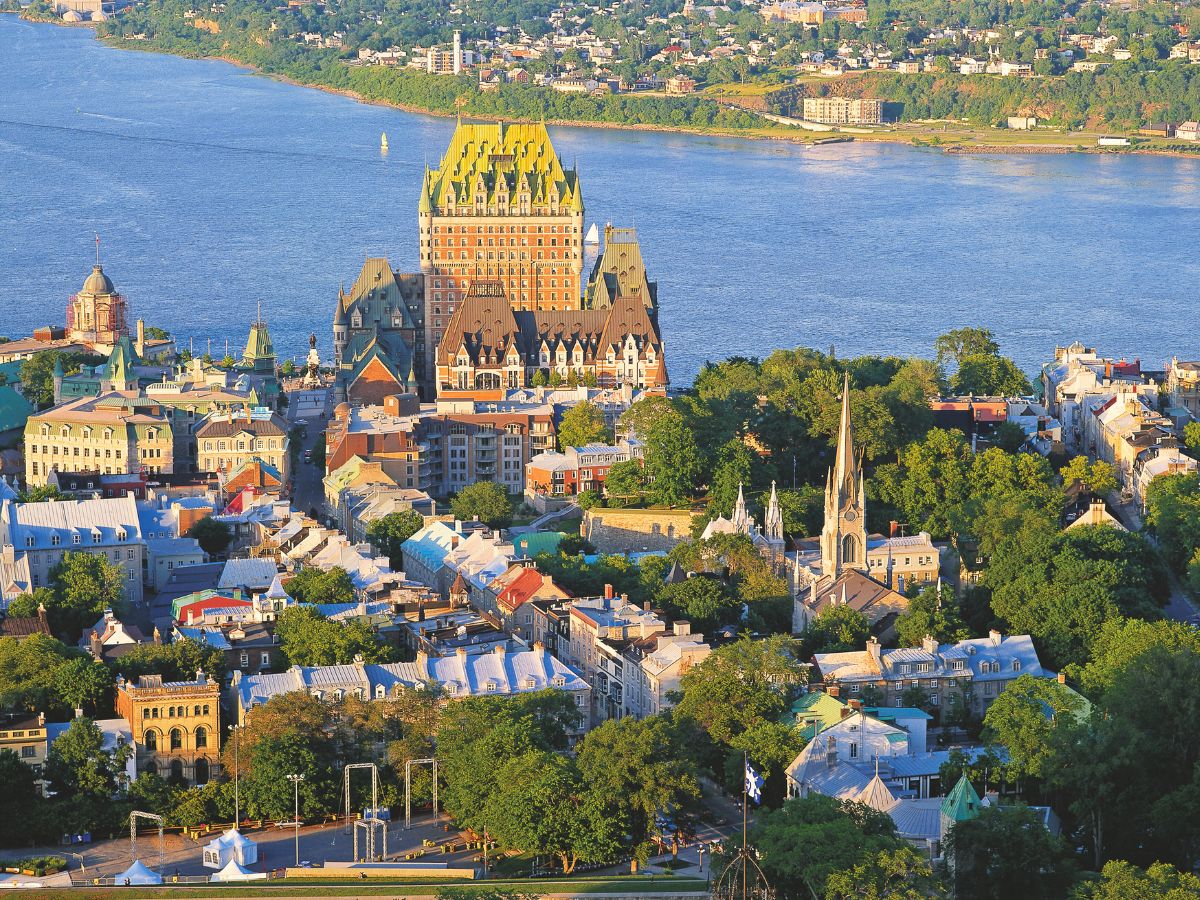 Quebec City views
Quebec City views
Québec City
Québec City would be a slight detour from your trip. However, it’s a detour worth taking.
If nothing else, a night in the truly iconic (and, even if that term might be overused, as the most photographed hotel in the world it really applies here) Fairmont Le Château Frontenac will make your time here well spent. Not only do you stay in a towering castle surrounded by city walls of the historic district of Old Québec, but it is regularly rated as one of the top 10 hotels in Canada.
Luckily, there is in fact much else to do in the city. Old Québec is like nowhere else in Canada. Walking the Petit-Champlain, the Terrasse Dufferin, or the Place Royale feels more like Europe than North America. And, complete with Le Funiculaire — the funicular taking visitors between the Upper and Lower Towns (and, in the process, avoiding some of the many long staircases scattered throughout the town), the Old Town is best explored by foot, and with ample time.
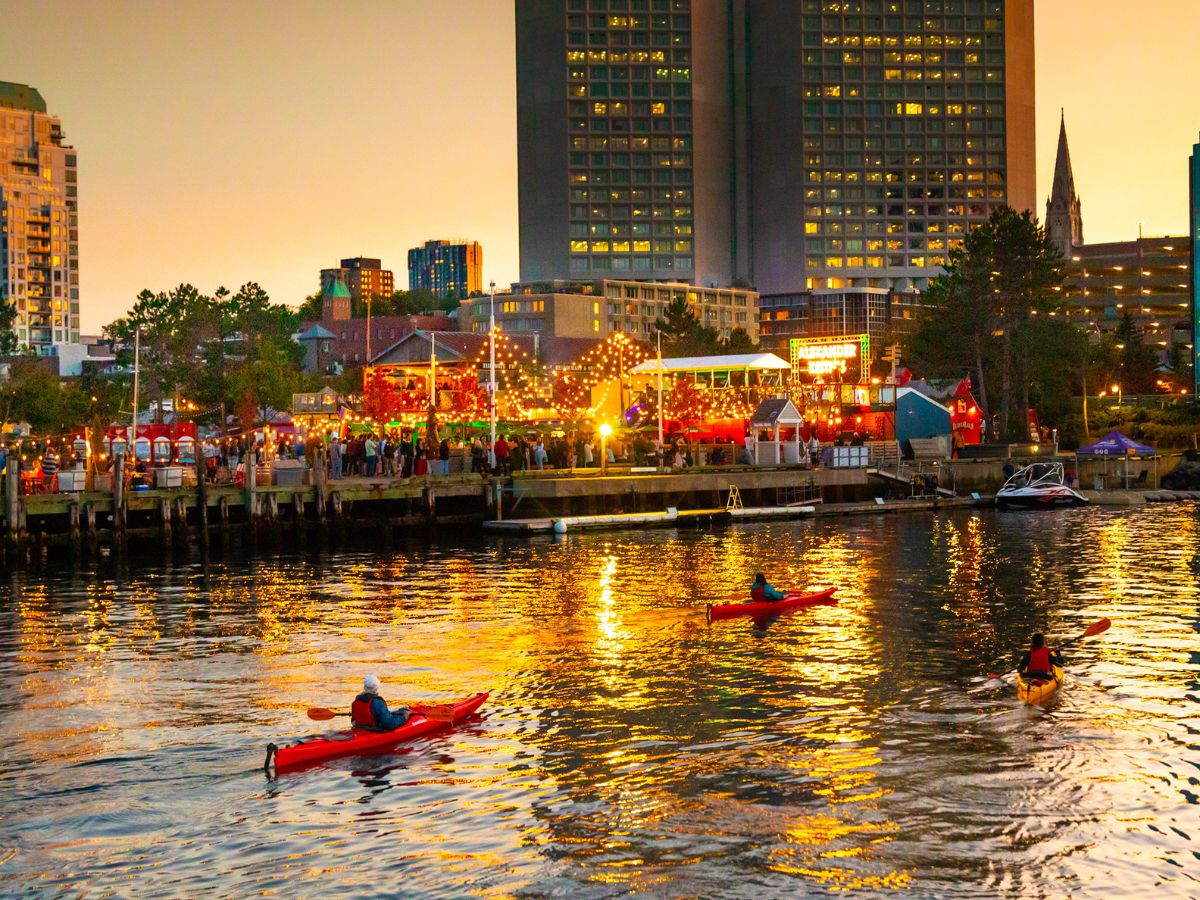 Halifax’s charming waterfront boardwalk
Halifax’s charming waterfront boardwalk
Halifax
Halifax is the other end of the trans-Canada railway. And you can feel that distance. The difference between the West Coast and the East Coast culture is stark. The difference is most apparent when walking the waterfront boardwalk — a fitting (and much quainter) parallel to Vancouver’s seawall on the opposite coast. And, to truly understand the difference in culture between the West and East coasts, sample some local specialties on the Halifax Harbourfront Food Walking Tour for a taste of some Maritime classics.
So, where to stop? If you’re looking for more time in nature, Vancouver and Jasper are the places for you. If you want to experience the buzz of a big city in Canada, spend extra time in Toronto. If you want to get your fill of history, Montréal and Québec City have the most to offer. And, if you want to relax in the cute, laid-back maritime charm, add on a night or two in Halifax.
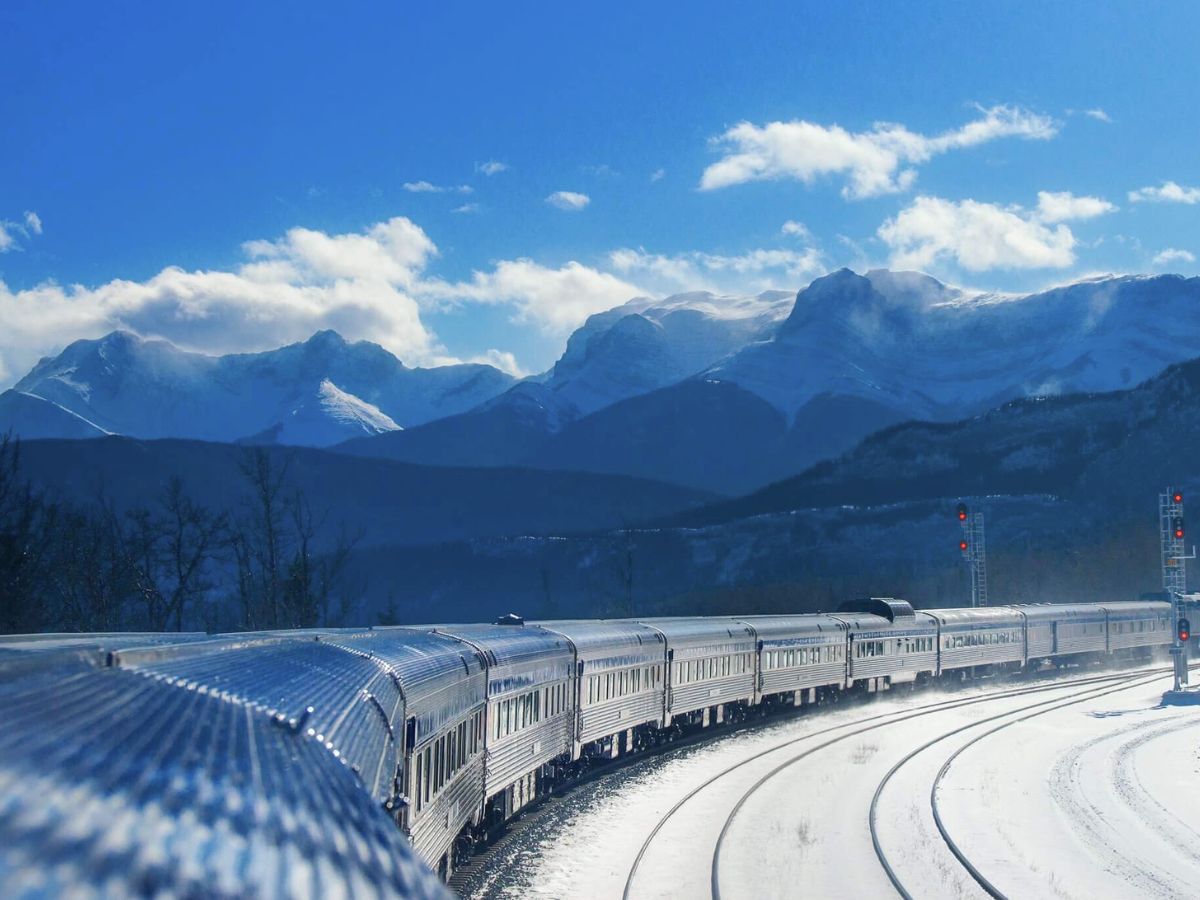 The Canadian heading towards the Rocky Mountains
The Canadian heading towards the Rocky Mountains
Popular Train Trips in Canada
Popular train trips in Canada vary by season. In the summer, we recommend the Grand Canadian Rail Journey. This Canada train package is great if you want longer daylight hours, for the maximum viewing time from onboard. You also get the choice of taking the Rocky Mountaineer through the West, which runs seasonally. Many attractions are only accessible during summer, so if hiking, rafting, and spotting a bear in the wild are what you’re looking for, a summer trip is for you.
In winter, we suggest the Trans Canada Winter Rail Vacation. And in opting for a winter train tour in Canada, you get to see the Great White North really do its thing. Miles upon miles of snow-covered landscapes rush past your window as you move from ice-capped mountains to frosty plains and beyond. If you choose a winter trip, continuing beyond Toronto and stopping in Old Québec is a must, as the city is really in its element in winter. In Québec City, you understand what a ‘winter wonderland’ is really meant to look like.
But you don’t have to decide now. Work one-on-one with your personal Travel Designer to create your best trans-Canada train adventure. They can advise you on everything from destinations to stop at, to the must-try food in each region.
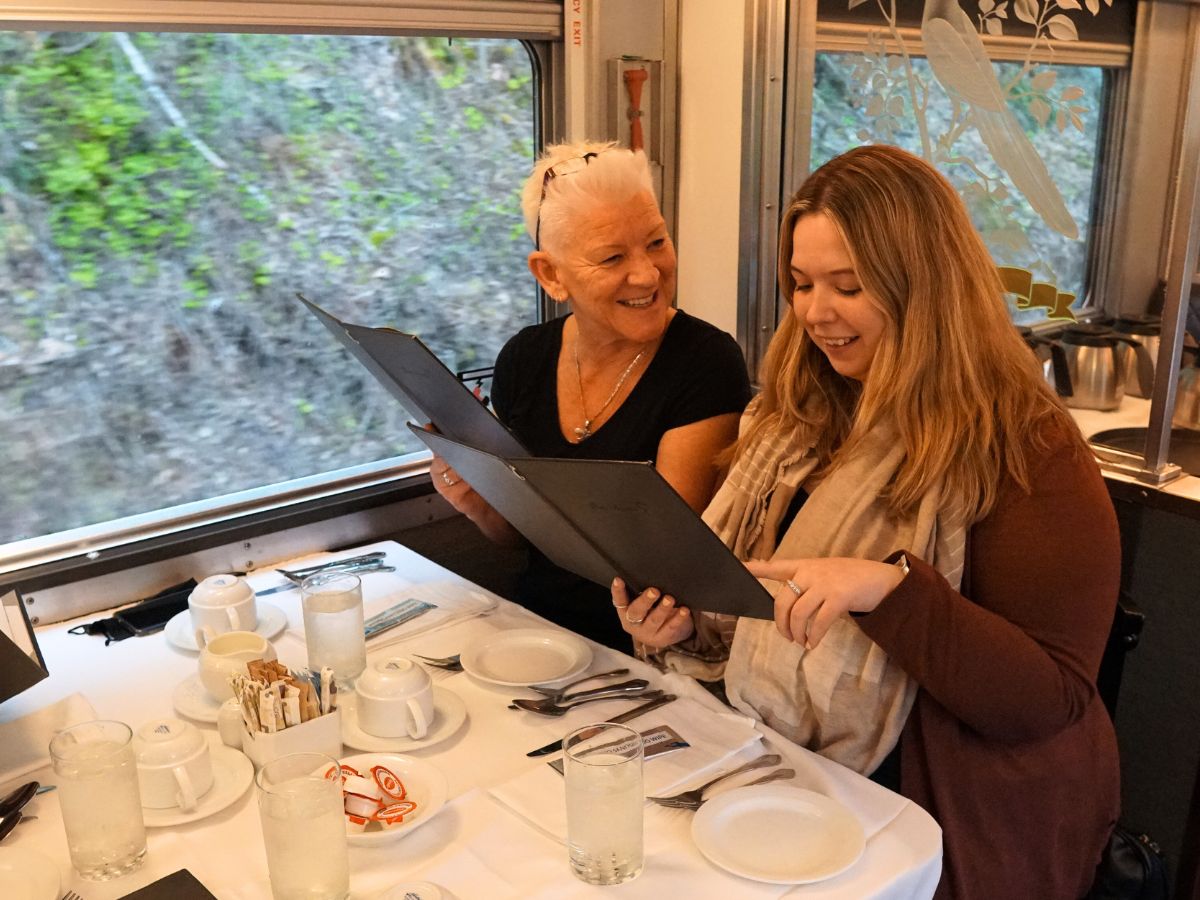 The Canada Rail Vacations team enjoying The Canadian’s dining car
The Canada Rail Vacations team enjoying The Canadian’s dining car
Quick Q&A
Is the train across Canada worth it?
Yes! You get to enjoy a slower pace of travel while still experiencing all Canada has to offer. And, you get access to parts of Canada a road can’t see.
How Much Does the Train in Canada Cost?
The price of a train in Canada depends on what trains you take, what service level you ride at, where you choose to stop, and how far you choose to go. However, if you’re traveling from America, you have the benefit of the US dollar (which goes a long way in Canada). For a train trip from Vancouver to Halifax, including the Rocky Mountaineer you can expect to spend anywhere between $7000 to $15,000 USD per person. But, if you’re looking for an exact price, reach out to a Travel Designer for a quote reflecting your own interests and wants.
How Long Does it Take to Cross Canada by Train?
From Vancouver to Halifax, the trip across Canada takes 7 days, with about 126 hours of on-board train time. But most travelers prefer to take longer, adding overnight stops in towns and cities they want to explore.
What is the Best Time to Take the Train in Canada?
This depends on what you want out of your trip. Summer is best for maximum sunlight hours for viewing, and the best access to outdoor excursions. But if you want a more private experience, and the experience of taking a snow train in the Rockies, you should consider a winter train.
What Should I Pack on a Canada Train Trip?
While large luggage can be checked in, for day-to-day necessities you should take a small bag. Consider packing cubes in your main luggage to hold daily essentials for easy removal at train stations and for organization on board.
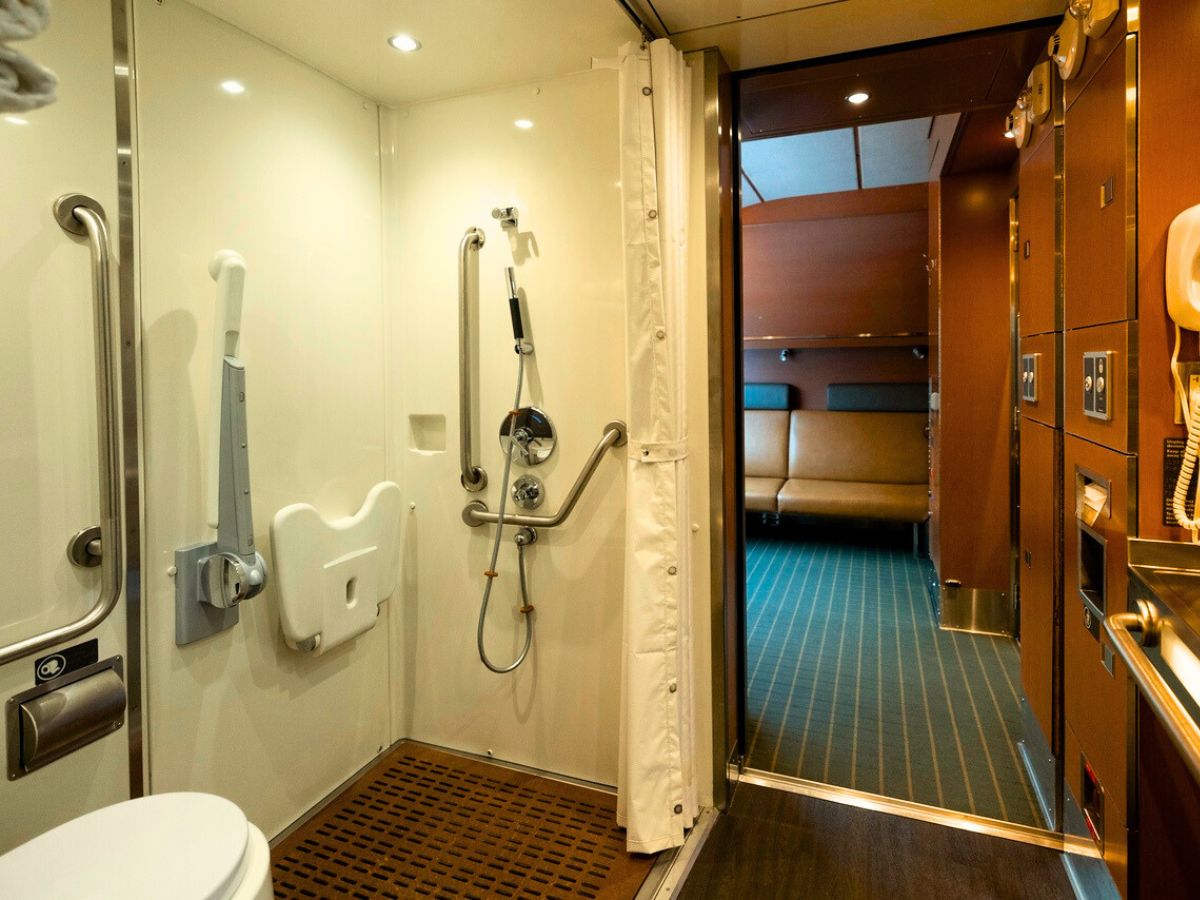 The Accessible Suite on board The Canadian
The Accessible Suite on board The Canadian
Is the Trans-Canada Rail Accessible?
Yes, both VIA Rail’s The Canadian and The Ocean have an accessible suite. It accommodates a person with a mobility aid (wheelchair or scooter) and up to one companion. The suite is complete with a fully accessible washroom, and mobility features throughout, and does not require additional purchase. If you want to request this suite, ask a Travel Designer for more details when requesting a quote.
Reach Out to Book a Trans-Canada Adventure Today
Get in touch with a Travel Designer to design your dream Canada trip today. Whether it's a coast-to-coast rail adventure, a wilderness viewing retreat, or a stunning Canadian Rockies tour, let us plan your perfect Canada vacation.
If you're still deciding (or just need a little more time), subscribe to our newsletter to stay in the loop and receive more inspiration, deals, and more.
Table of Contents
- History of the Train Across Canada
- Major Train Routes in Canada
- Rocky Mountaineer
- The Canadian
- The Corridor
- The Ocean
- Scenic Adventure Routes
- How to Take a Train Across Canada
- Life on the Trans-Canada Train
- The Canadian
- The Corridor
- The Ocean
- The Rocky Mountaineer
- Secret Top Travel Tip
- Stops on the Trans-Canada Train
- Vancouver
- Jasper
- Toronto
- Montréal
- Québec City
- Halifax
- Popular Train Trips in Canada
- Quick Q&A
- Is the train across Canada worth it?
- How Much Does the Train in Canada Cost?
- How Long Does it Take to Cross Canada by Train?
- What is the Best Time to Take the Train in Canada?
- What Should I Pack on a Canada Train Trip?
- Is the Trans-Canada Rail Accessible?
- Reach Out to Book a Trans-Canada Adventure Today

